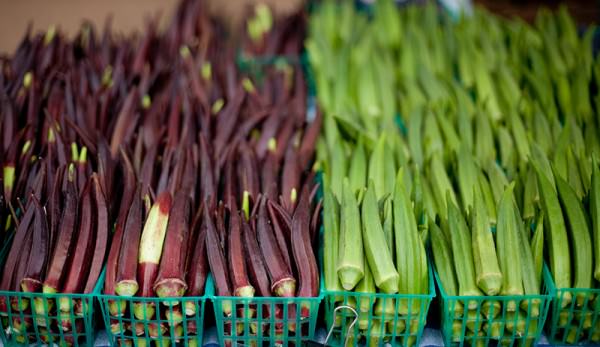
As a Southerner, I will eat okra any way you give it to me: fresh-picked, in a stew, lightly sautéed, deep-fried. I even like it pickled and used as a stir stick in a Bloody Mary. But my New Englander wife has a different take: Yuck, too slimy.
Okra (Hibiscus esculentus) is a warm-weather-loving plant from Ethiopia. Plant the big seeds a foot apart outdoors in the vegetable garden when the soil temperature reaches about 65 degrees. In zone 7, where I live in North Carolina, that’s the month of May. The large, deep-green leaves are scratchy and hairy, which is a clue that okra can withstand hot, dry conditions. It’s not a mistake to mix some into a bed of ornamentals, as they add height and beauty; depending on the variety, they will grow from 4 to 10 feet tall and have big, hibiscus-like blooms. An eye-catching variety called Red Burgundy from Clemson University is 4 feet tall, delicious and ornamental: the stems, leaf ribs and fruit are burgundy red; the leaves, bright green; and the flowers, lemon yellow with a red throat.
After less than two months’ growth, the seedpods are edible and can be harvested every couple days until fall weather stops them. The pointed pods can get 8 to 12 inches long—a proper size for seed saving and even making rope. As for eating, they have the best texture when harvested young at 3 to 4 inches long. Those with sharper palates than mine describe a flavor between asparagus and eggplant. Red Okra and Star of David are two good heirloom varieties, but any variety will crisp up in the oven and convert okra haters into okra lovers this summer.
In African, Indian, Cajun and Southern cuisines, okra’s sliminess is valued as a thickening agent in soups, stews and gumbo. While talking about okra with the woman working the checkout counter at a local grocery store, I learned about a technique that will turn an okra hater into an okra lover.
To start, cut off the stems of some fresh okra and slice the okra in half lengthwise. Slather on some oil, salt and pepper, the same as you would when roasting root vegetables. Spread the okra cut-side down on a cookie sheet so they aren’t touching. Roast at 425 degrees F for about 35 minutes until they are crispy brown. Because okra size varies, as does oven heat, monitor your first couple of batches closely because they can quickly go from crispy brown to crackly black. Eat them hot.
With this recipe, you get the crispiness of French fries, the summery flavor of okra and absolutely none of the sliminess. Repentant okra haters will fight over the last ones.




